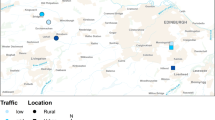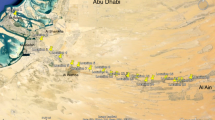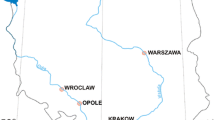Abstract
The elemental analysis of road dust can be used to determine the contribution of traffic-related metal emissions to the local environment. Previous studies have shown that brake wear, tire wear, and lead wheel weights release significant amounts of metals that lead to decreased biodiversity and degradation of urban streams. Highway pavement has not previously been considered as a source of metal inputs into the environment. To determine the extent that highway pavement contributes to metal loads in the local environment, road dust and pavement samples were collected for both asphalt and concrete pavement types on State Highway 59 in Houston, TX, USA. Samples were analyzed by ICP-MS to quantitate 9 metals: aluminum (Al), iron (Fe), vanadium (V), chromium (Cr), nickel (Ni), cobalt (Co), copper (Cu), zinc (Zn), and lead (Pb). A chemical mass balance receptor model that is commonly used for source apportionment of air pollution was applied to heavy metals in road dust, with brake dust, tire wear, wheel weights, and pavement materials as the emission sources. Pavement is shown to be the primary source of V, Cr, Ni, and Co in road dust, regardless of asphalt or concrete pavement type. Lead concentration in road dust is influenced by pavement type, with concrete pavement contributing approximately 45% of total lead in concrete road dust, while asphalt pavement only contributes 27% of total lead in asphalt road dust. Fly ash is the likely component of concrete pavement responsible for the higher contribution of Pb. An enrichment factor analysis indicates that Cr, Co, and V have low levels of enrichment compared to Cu, Zn, Pb, and Ni, indicating that pavement wear is generally a minor source of environmental metal contamination compared to brake and tire wear. Currently, brake and tire wear are the non-exhaust vehicle emissions of greatest concern; however, alternatives to fly ash should be considered to further reduce Pb and Ni concentrations in the environment.



Similar content being viewed by others
References
Adgate, J. L., Willis, R. D., Buckley, T. J., Chow, J. C., Watson, J. G., Rhoads, G. G., & Lioy, P. J. (1998). Chemical mass balance source apportionment of lead in house dust. Environmental Science & Technology, 32(1), 108–114.
Apeagyei, E., Bank, M. S., & Spengler, J. D. (2011). Distribution of heavy metals in road dust along an urban-rural gradient in Massachusetts. Atmospheric Environment, 45, 2310–2323.
Bozlaker, A., Buzcu-Güven, B., Fraser, M. P., & Chellam, S. (2013). Insights into PM10 sources in Houston, Texas: Role of petroleum refineries in enriching lanthanoid metals during episodic emission events. Atmospheric Environment, 69, 109–117.
Chang, S. H., Wang, K. S., Chang, H. F., Ni, W. W., Wu, B. J., Wong, R. H., & Lee, H. S. (2009). Comparison of source identification of metals in road-dust and soil. Soil and Sediment Contamination, 18, 669–683.
Charlesworth, S., Everett, M., McCarthy, R., Ordonez, A., & De Miguel, E. (2003). A comparative study of heavy metal concentration and distribution in deposited street dusts in a large and a small urban area: Birmingham and Coventry, West Midlands, UK. Environment International, 29, 563–573.
de Miguel, E., Llamas, J. F., Chacón, E., Berg, T., Larssen, S., Røyset, O., & Vadset, M. (1997). Origin and patterns of distribution of trace elements in street dust: unleaded petrol and urban lead. Atmospheric Environment, 31(17), 2733–2740.
Denys, S., Caboche, J., Tack, K., Rychen, G., Wragg, J., Cave, M., et al. (2012). In vivo validation of the unified BARGE method to assess the bioaccessibility of arsenic, antimony, cadmium, and lead in soils. Environmental Science & Technology, 46(11), 6252–6260.
Dietrich, M., Huling, J., & Krekeler, M. P. (2018). Metal pollution investigation of Goldman Park, Middletown Ohio: Evidence for steel and coal pollution in a high child use setting. Science of the Total Environment, 618, 1350–1362.
Dora, C., Hosking, J., Mudu, P., & Fletcher, E. R. (2011). Urban transport and health. Module 5g. Sustainable transport: a sourcebook for policy-makers in developing cities. Ginebra: WHO/GTZ. Available at: https://www.who.int/hia/green_economy/giz_transport.pdf?ua=1.
Duong, T. T., & Lee, B. K. (2011). Determining contamination level of heavy metals in road dust from busy traffic areas with different characteristics. Journal of Environmental Management, 92, 554–562.
Fiala, M., & Hwang, H. M. (2019). Development of a static model to identify best management practices for trace metals from non-exhaust traffic emissions. Environmental Processes, 6(2), 377–389.
Fujiwara, F., Rebagliati, R. J., Dawidowski, L., Gómez, D., Polla, G., Pereyra, V., & Smichowski, P. (2011). Spatial and chemical patterns of size fractionated road dust collected in a megacitiy. Atmospheric Environment, 45(8), 1497–1505.
Gunawardana, C., Goonetilleke, A., Egodawatta, P., Dawes, L., & Kokot, S. (2012). Source characterisation of road dust based on chemical and mineralogical composition. Chemosphere, 87(2), 163–170.
Hamilton, E. M., Barlow, T. S., Gowing, C. J., & Watts, M. J. (2015). Bioaccessibility performance data for fifty-seven elements in guidance material BGS 102. Microchemical Journal, 123, 131–138.
Hjortenkrans, D., Bergbäck, B., & Häggerud, A. (2006). New metal emission patterns in road traffic environments. Environmental Monitoring and Assessment, 117(1), 85–98.
Hopke, P. K. (2016). Review of receptor modeling methods for source apportionment. Journal of the Air & Waste Management Association, 66(3), 237–259.
Hornberger, M. I., Luoma, S. N., van Geen, A., Fuller, C., & Anima, R. (1999). Historical trends of metals in the sediments of San Francisco Bay, California. Marine Chemistry, 64(1), 39–55.
HWA. (1998). Materials notebook. In Chapter 5: Portland cement concrete. Federal Highway: Administration https://www.fhwa.dot.gov/pavement/materials/matnote.cfm.
Hwang, H. M., Fiala, M., Park, D., & Wade, T. (2016). Review of pollutants in urban road dust and stormwater runoff: Part 1. Heavy metals released from vehicles. International Journal of Urban Sciences, 20(3), 334–360.
Hwang H.M., Fiala M., Wigart R., Townsend R., and Edirveerasingam V. (2017). Sources of fine sediment particles (< 20 μm) in urban roadway runoff in the Lake Tahoe Basin. Prepared for Pacific Southwest Research Station, United States Department of Agriculture Forest Service.
Hwang, H. M., Fiala, M. J., Wade, T. L., & Park, D. (2019). Review of pollutants in urban road dust: Part II. Organic contaminants from vehicles and road management. International Journal of Urban Sciences, 23(4), 445–463.
Kennedy, P., Gadd, J., & Moncrieff, I. (2002). Emission factors for contaminants released by motor vehicles in New Zealand. Prepared for the New Zealand Ministry of Transport and Infrastructure Auckland.
Khairy, M. A., Barakat, A. O., Mostafa, A. R., & Wade, T. L. (2011). Multielement determination by flame atomic absorption of road dust samples in Delta Region, Egypt. Microchemical Journal, 97(2), 234–242.
Latimer, J. S., Hoffman, E. J., Hoffman, G., Fasching, J. L., & Quinn, J. G. (1990). Sources of petroleum hydrocarbons in urban runoff. Water, Air, and Soil Pollution, 52(1), 1–21.
LeGalley, E., Widom, E., Krekeler, M. P., & Kuentz, D. C. (2013). Chemical and lead isotope constraints on sources of metal pollution in street sediment and lichens in southwest Ohio. Applied Geochemistry, 32, 195–203.
Li, Q., Qiao, F., & Yu, L. (2016). Impacts of pavement types on in-vehicle noise and human health. Journal of the Air & Waste Management Association, 66(1), 87–96.
MPCA. (n.d.). Lead and mercury wheel weights. Minnesota Pollution Control Agency. Retrieved from: https://www.pca.state.mn.us/quick-links/lead-and-mercury-wheel-weights.
O’Shea, M. J., Vann, D. R., Hwang, W. T., & Gieré, R. (2020). A mineralogical and chemical investigation of road dust in Philadelphia, PA, USA. Environmental Science and Pollution Research, 1–20.
Rajaram, B. S., Suryawanshi, P. V., Bhanarkar, A. D., & Rao, C. V. C. (2014). Heavy metals contamination in road dust in Delhi city, India. Environmental Earth Sciences, 72(10), 3929–3938.
Rasmussen, P. E., Subramanian, K. S., & Jessiman, B. J. (2001). A multi-element profile of house dust in relation to exterior dust and soils in the city of Ottawa, Canada. Science of the Total Environment, 267(1–3), 125–140.
Santschi, P. H., Presley, B. J., Wade, T. L., Garcia-Romero, B., & Baskaran, M. (2001). Historical contamination of PAHs, PCBs, DDTs, and heavy metals in Mississippi river Delta, Galveston bay and Tampa bay sediment cores. Marine Environmental Research, 52(1), 51–79.
Schiff, K. C., & Weisberg, S. B. (1999). Iron as a reference element for determining trace metal enrichment in Southern California coastal shelf sediments. Marine Environmental Research, 48(2), 161–176.
Shi, G., Chen, Z., Xu, S., Zhang, J., Wang, L., Bi, C., & Teng, J. (2008). Potentially toxic metal contamination of urban soils and roadside dust in Shanghai, China. Environmental Pollution, 156(2), 251–260.
Symanski, E., An Han, H., Hopkins, L., Smith, M. A., McCurdy, S., Han, I., … & Flores, J. (2020). Metal air pollution partnership solutions: Building an academic-government-community-industry collaboration to improve air quality and health in environmental justice communities in Houston. Environmental Health, 19, 1–12.
Tanner, P. A., Ma, H. L., & Yu, P. K. N. (2008). Fingerprinting metals in urban street dust of Beijing, Shanghai and Hong Kong. Environmental Science and Technology, 42, 7111–7117.
TxDOT. (n.d.) Statewide Planning Map. Texas Department of Transportation. Available at: https://www.txdot.gov/apps/statewide_mapping/StatewidePlanningMap.html. Accessed 04/04/2020.
US Census Bureau Population Division. 2019. Annual estimates of the resident population: April 1, 2010 to July 1, 2018 - United States -- Metropolitan and Micropolitan Statistical Area. https://factfinder.census.gov/faces/nav/jsf/pages/index.xhtml.
US EPA. (1973). Toxic materials analysis of street surface contaminants (environmental protection technology series, EPA-R2–73-283). Office of Research and Development, United States Environmental Protection Agency.
US EPA. 2007. Method 3051A, microwave assisted acid digestion of sediments, sludges, soils, and oils. https://www.epa.gov/sites/production/files/2015-12/documents/3051a.pdf.
Watson, J. G., Chow, J. C., & Pace, T. G. (1991). Chemical mass balance receptor modeling for air quality management, Hopke, PK editor.
Wedepohl, K. H. (1995). The composition of the continental crust. Geochimica et Cosmochimica Acta, 59(7), 1217–1232.
Wise Jr, J. P., Wise, J. T., Wise, C. F., Wise, S. S., Gianios Jr, C., Xie, H., ... & Wise Sr, J. P. (2014). Concentrations of the genotoxic metals, chromium and nickel, in whales, tar balls, oil slicks, and released oil from the gulf of Mexico in the immediate aftermath of the Deepwater Horizon oil crisis: Is genotoxic metal exposure part of the Deepwater Horizon legacy?. Environmental Science & Technology, 48(5), 2997–3006.
Zischka, M., Schramel, P., Muntau, H., Rehnert, A., Gomez, M., Wannemaker, G., Dams, R., Quevauviller, P., and Maier, E. (2002). Reference materials. The certification of the contents (mass fractions) of palladium, platinum and rhodium in road dust BR-723. European Commission. GCR Research Center for Environment and Health. Report EUR 20307 EN. Available at: https://crm.jrc.ec.europa.eu/p/40455/40459/By-material-matrix/Soils-sludges-sediment-dust/BCR-723-ROAD-DUST-Pd-Pt-Rh/BCR-723.
Funding
This work was supported by the National Science Foundation under Grant # HRD-1345173.
Author information
Authors and Affiliations
Corresponding author
Ethics declarations
Conflict of Interest
The authors declare no competing interests.
Additional information
Publisher’s Note
Springer Nature remains neutral with regard to jurisdictional claims in published maps and institutional affiliations.
Supplementary Information
ESM 1
(DOCX 21 kb)
Rights and permissions
About this article
Cite this article
Fiala, M., Hwang, HM. Influence of Highway Pavement on Metals in Road Dust: a Case Study in Houston, Texas. Water Air Soil Pollut 232, 185 (2021). https://doi.org/10.1007/s11270-021-05139-7
Received:
Accepted:
Published:
DOI: https://doi.org/10.1007/s11270-021-05139-7




